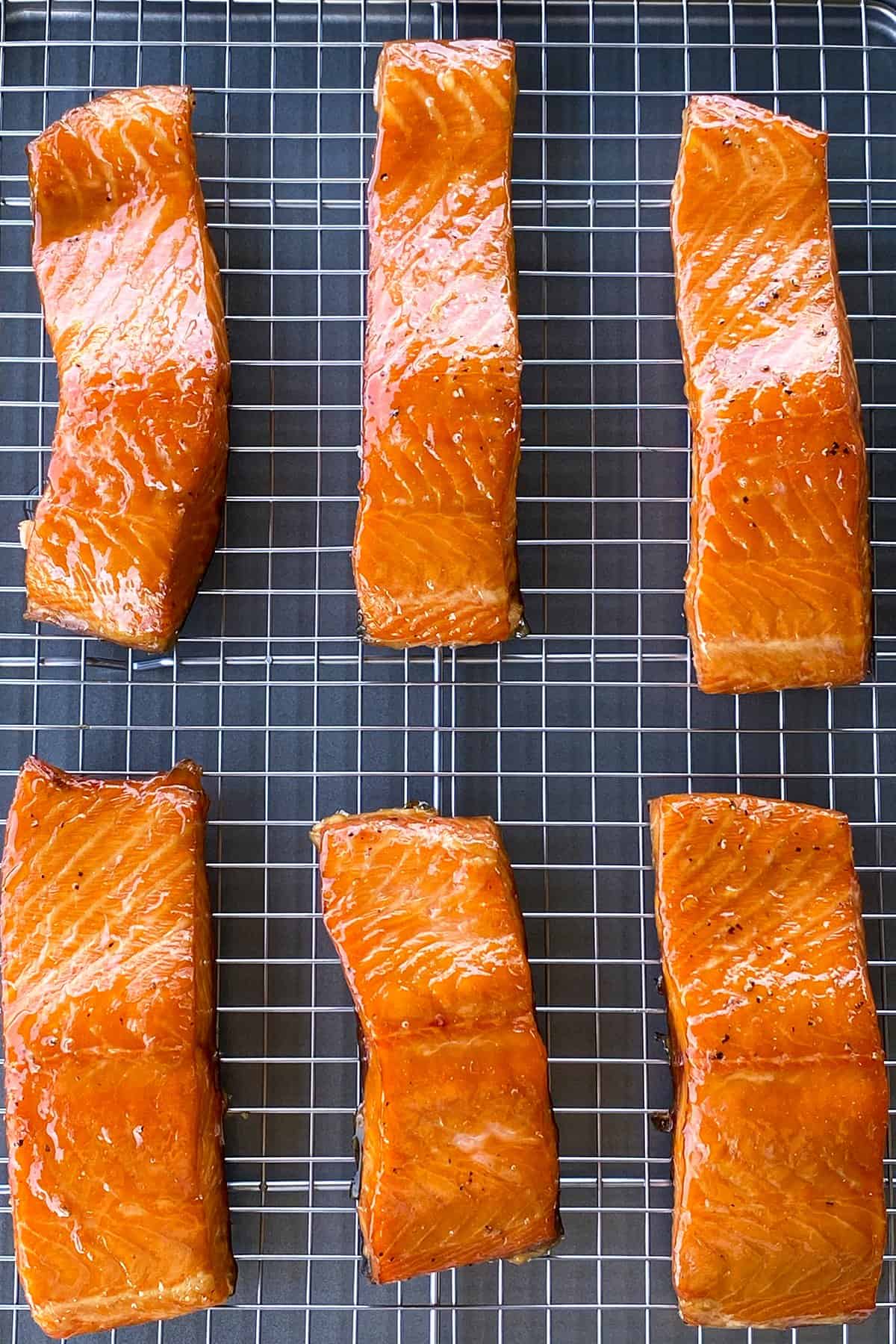
This easy step by step guide to smoked salmon recipe will show you just how to smoke salmon at home using fish you bought at grocery stores or caught yourself. Not only is the recipe “beginner-level-easy”, but it’s also the truly best smoked salmon recipe I’ve ever eaten.
Whether you’re looking for a stash of the best smoked salmon to pop on a bagel slathered with cream cheese or to make our Smoked Salmon Pasta Salad or Smoked Salmon Cucumber Pizza, you’re going to be converted to making your own salmon in all its smoky perfection.

If smoking fish is something that intimidates you, I’m here to help! I promise this easy recipe is broken down into simple steps that anyone can follow!
It’s true that the smoking process for salmon requires a little more than just slapping fish filets on a grill. But the steps are quite simple and the majority of the time is just the fish being parked in brine in the refrigerator.
If you haven’t smoked foods before, please read the whole post to learn why each step is necessary. If you’re an old hand at smoking, feel free to use the “Jump to Recipe” button at the top of the post.
All you need is a handful of ingredients that are readily available at almost any store, a smoker with pellets or wood, an airtight container for brining your salmon, a cooling rack, and a rimmed baking sheet.
Oh, and you need an electric fan. “A fan?” quoth you.
Yes. A fan. But we’ll get into that in a moment.
In case you’re concerned about what kind of time and effort commitment you need to put in for this recipe, let me give you the quick version of what has to happen to make this easy smoked salmon recipe.
- Remove any pin bones from the salmon filet. If you’re using a larger piece of salmon, cut it into single serving sized pieces about 3-inches wide.
- Whisk together your brine ingredients in a tupperware or gladware container with a tight fitting lid.
- Submerge your salmon in the brine. Put the lid on tight and refrigerate it at least 4 hours but up to 8 hours.
- Rinse your salmon and place it on a cooling rack set on a sheet pan.
- Pat the surface of the fish dry with paper towels.
- Place the pan in front of an electric fan in a relatively cool room for at least an hour or until the surface is shiny and somewhat tacky. Now you can either refrigerate it until the following day or go directly to the smoker with it.
- Oil the skin side of the salmon fillet and place it directly on the smoker grates. Smoke for 2 to 3 hours, or until the internal temperature of the salmon reaches 130ºF to 140ºF brushing with maple syrup after the first hour and every 60 minutes after that.
- Move the smoked salmon to a cooling rack, brush once more with maple syrup or honey, and let it cool completely before wrapping tightly and refrigerating for up to a week or freezing for up to a year.
Now that you know how easy it is, we need to discuss the star of the show: Salmon. What kind of salmon do we smoke?
Smoke Salmon How To
This all begins with choosing salmon to smoke. The flesh of the salmon has a high fat content which makes it take on a smoke flavor quite easily. Thankfully, the type of salmon acceptable for smoking is pretty much open here as long as you observe a couple of rules.
Whether it’s King salmon, Copper River salmon, Pacific Northwest or Atlantic salmon, Sockeye salmon farmed or wild salmon, frozen salmon, or fresh salmon, it’s all good as long as you pick a relatively thick salmon filet that has the skin on. Even those two points are negotiable depending on the results you’re looking for.
If you’re inclined to go with a skinless filet rather than a skin-on filet, remember that the fish is likelier to stick to your grill grates. You will want to be assiduous about oiling them before adding your fish to the grill. Alternatively, you could use a grill basket to make things easier on yourself.
And if all you can lay your hands on is a thinner rather than thicker fillet, don’t despair. You can still smoke those thinner pieces, you’ll just want to watch the internal temperature of the salmon more carefully to assure that you don’t go too far with it.
If you do take it a bit too far, don’t worry too much over that either! In fact, if you find yourself in this situation the solution is to keep smoking it even more and turn it into salmon bacon! Instructions for salmon bacon are included below in the printable recipe.
How to Brine Salmon
Of all the things to brine, salmon very well may be the easiest. But why brine it at all? It’s all in the science.
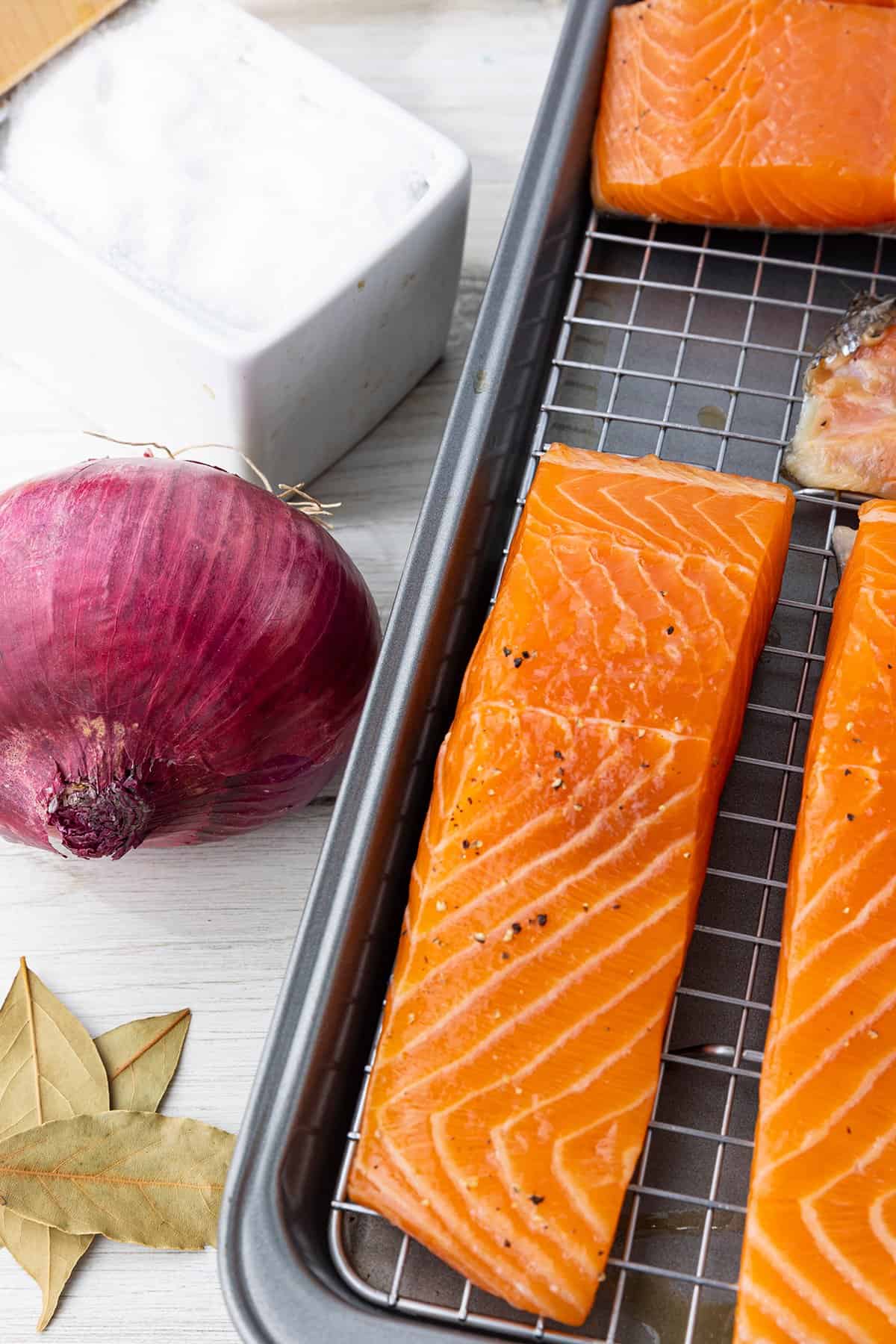
When you brine or cure salmon, you do two crucial things. First, you season the flesh of the salmon all the way to the center of the filet which helps improve the overall flavour.
Second -and just as importantly- though, you improve the texture by partially dissolving muscle fibers creating a gel that helps retain water. This helps retain moisture during the smoking process.
In the meanwhile, the sugar in the brine is “hygroscopic”. That means it attracts water or moisture from its environment. The sugar not only adds a little sweetness to your smoked fish, but also helps the fish hold onto the moisture you added when you brined it.
In other words, you keep it juicier and tastier by brining it. While it does mean a couple extra hours of waiting before you can sink your teeth into that succulent smoked salmon, it is well worth it.
The curing process is ridiculously easy. You simply whisk together cold water, kosher salt, dark brown sugar, and some aromatics.
We use one sliced red onion, some black pepper, and -from time to time- a couple of lemon slices. Dissolve the sugar and salt then slide your fillets in skin side up. Cover tightly with plastic wrap or a tight fitting lid, and slide it into the refrigerator for 4 to 8 hours.
If you like a mild flavor, you can pull the onions from the brine at the halfway mark. The longer you leave the onions in the brine, the more prominent the onion presence will be in the final smoked fish.
After brining, rinse the fish fillets a quickly to help eliminate some of the surface salt. This helps keep the salmon from being too salty.
After you brine the fish and rinse it off, you’ll need to dry it off. It might sound counterintuitive to dry the fish after you “moisturize” it, but again, science rules the roost here.
You’ve added all that lovely seasoning into the fish, and it’d be a shame to have it evaporate in the process of smoking. To help “seal” it in, you need to develop a pellicle.
The pellicle is a shiny, laquer-like layer on the outside of the salmon that the smoke just plain loves. It absorbs the smoke while simultaneously preventing loss of moisture in your fabulous brined salmon.
A pellicle is achieved by air-flow and cooler temperatures. Here’s how we do it.
First pat the rinsed fillets with paper towels to remove excess moisture. I put my brined and patted-dry salmon filets on a wire rack on a baking sheet and park it in front of a powerful electric fan in the coolest room in my house.
Does that mean that from time to time salmon is on a stool in front of a fan in my air conditioned bedroom? It sure does.
In cooler months, you can put it anywhere that is 60ºF or lower (but above freezing) in front of a fan. It’s the combination that does the trick!
You don’t need to worry about food safety here for the hour or so that it takes to develop the pellicle. Your brine has a preservative effect between the salt and sugar in it, so you’re perfectly safe doing this.
If you need to, you can pop the sheet pan into the refrigerator (uncovered, of course!) for up to 24 hours after forming your pellicle. It’ll be just fine. Just take it out and let it sit at room temperature for about an hour before popping onto the smoker.
What Type of Smoker Do I use for Smoked Salmon?
In short, use whatever you have! This whole process is made significantly easier if you have a Traeger smoker a.k.a. pellet grill or an electric smoker because you want to keep it at a low temperature, starting at about 165ºF and moving slowly upward to no higher than 225ºF toward the end.
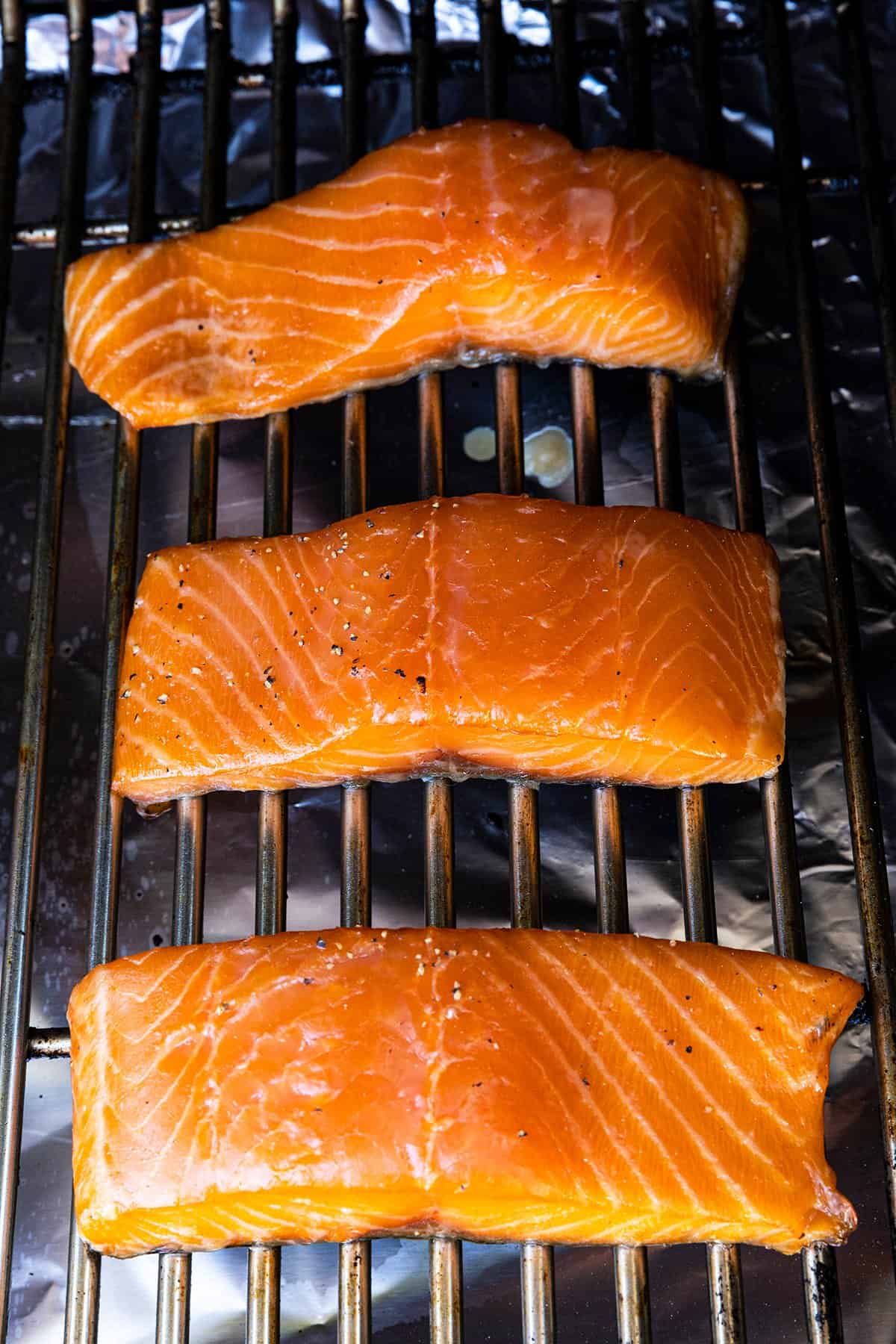
Ideally, the bulk of the smoking will happen around 185ºF. This is obviously easiest to do with a grill or smoker that allows you to set the temperature with a dial or digital display.
PRO TIP:
I position my salmon on my Traeger before it has come to full temperature. I find that helps minimize the appearance of albumin because the fish heats up slowly with the smoker. (More on this in the next section.)
Because we are hot smoking instead of cold smoking, you don’t actually need to have a dedicated smoker for the project. Our hot smoked salmon recipe can also be made on a charcoal or gas grill. You will just have to pay a little more attention to maintaining the temperature of your grill.
If you use gas grill, you’ll need to finagle the heat source so that you keep it in that low temperature wheelhouse. You’ll also need to add a smoke box to the grill, replenishing it from time to time. Because they’re inexpensive, it might even be worth having two to cycle through.
You’ll want to keep an eye on the actual temperature of your grill or smoker. This can be different than what the gauge says on your grill if you haven’t calibrated it in a while.
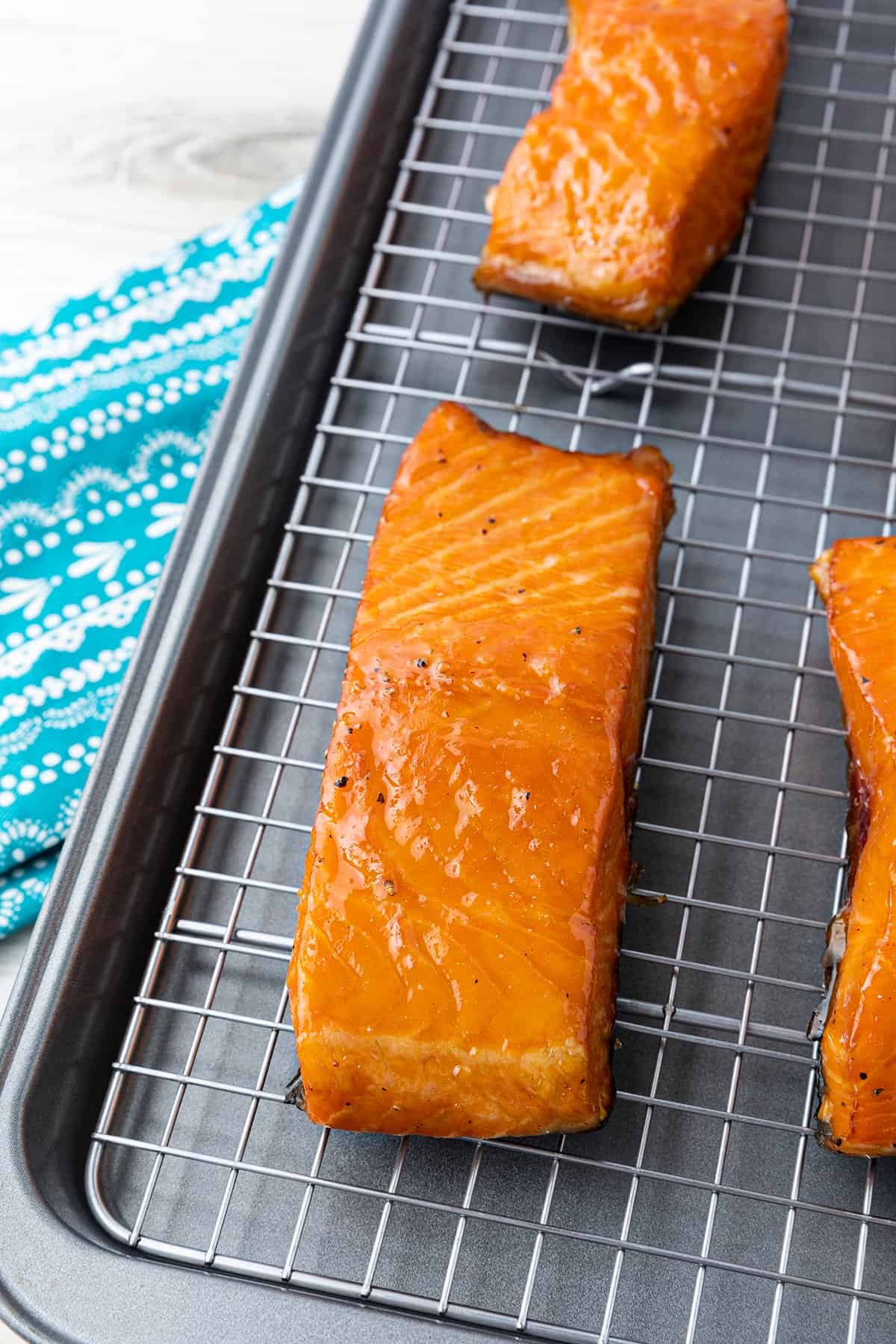
Pop an el-cheapo oven thermometer in the grill or use a nifty probe thermometer in the fish. This lets you keep tabs without opening the grill and letting out all of the smoke and heat.
Things to Remember When You’re Smoking Salmon
Have you ever cooked salmon and wondered what the heck that white stuff was that was coming out of it? It’s albumin and it’s perfectly harmless if a little unappetizing looking.
In salmon’s raw state, albumin is a clear, liquid protein. As you expose the fish to heat, the protein coagulates to an opaque, white, semi-solid.
The more aggressively you cook the salmon, the more albumin you’ll find rising to the surface. Again, this is not a big deal, but it’s not so pretty. It also means that the cooked salmon may dry out a little more than you’d like for it to.
The long, slow, gentle heat we use to smoke salmon should eliminate much, if not most of the visible albumin. Just be sure to bring the temperature up slow-and-steady. Any albumin that *does* have the nerve to show up should be swiped away as you brush the fish filets with maple syrup hourly after the first hour of uninterrupted smoking.
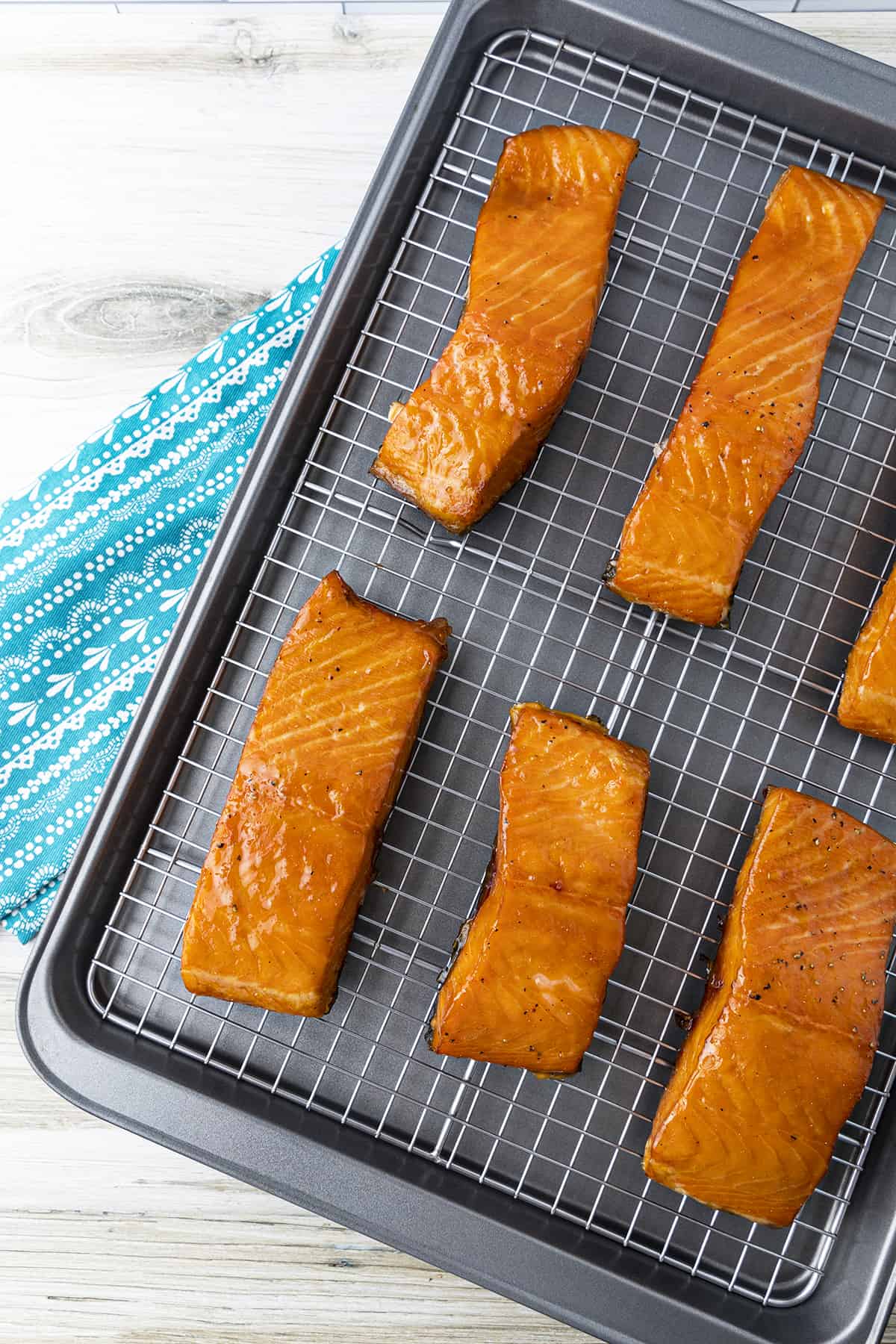
I said it before, but it bears repeating: salmon loves to stick to the smoker rack. Please oil the skin (and skin only!!) of the salmon generously before sliding it onto your grates.
And for the love of smoked fish, please do not oil the top of the salmon. It’ll undo all that time you spent developing the pellicle on the salmon. Your end product will suffer in both texture and flavour.
How Long to Smoke Salmon
Set your timer for an hour when the salmon first goes onto the smoker or grill. You’re looking to smoke your salmon for an hour at 165º. After one hour, raise the heat to 180ºF.
It should take about two hours total to bring the salmon to an internal temperature of 130ºF. Please note I said “about two hours”.
There are so many outside factors that contribute to how long it takes to smokes salmon; fom the thickness of the filets to the fat content in them and on to the outdoor temperature and humidity. For flakier rather than slice-able salmon, you can take it closer to 140ºF without over-drying it.
If you’d like a not quite as heavily smoked salmon, you can move it to a pre-heated low oven after the first hour of smoking. You’ll want to keep the temperature of your oven between 185ºF and 200ºF if you opt to do this.
Please remember to baste the salmon with maple syrup or honey after each hour on the smoker or grill.
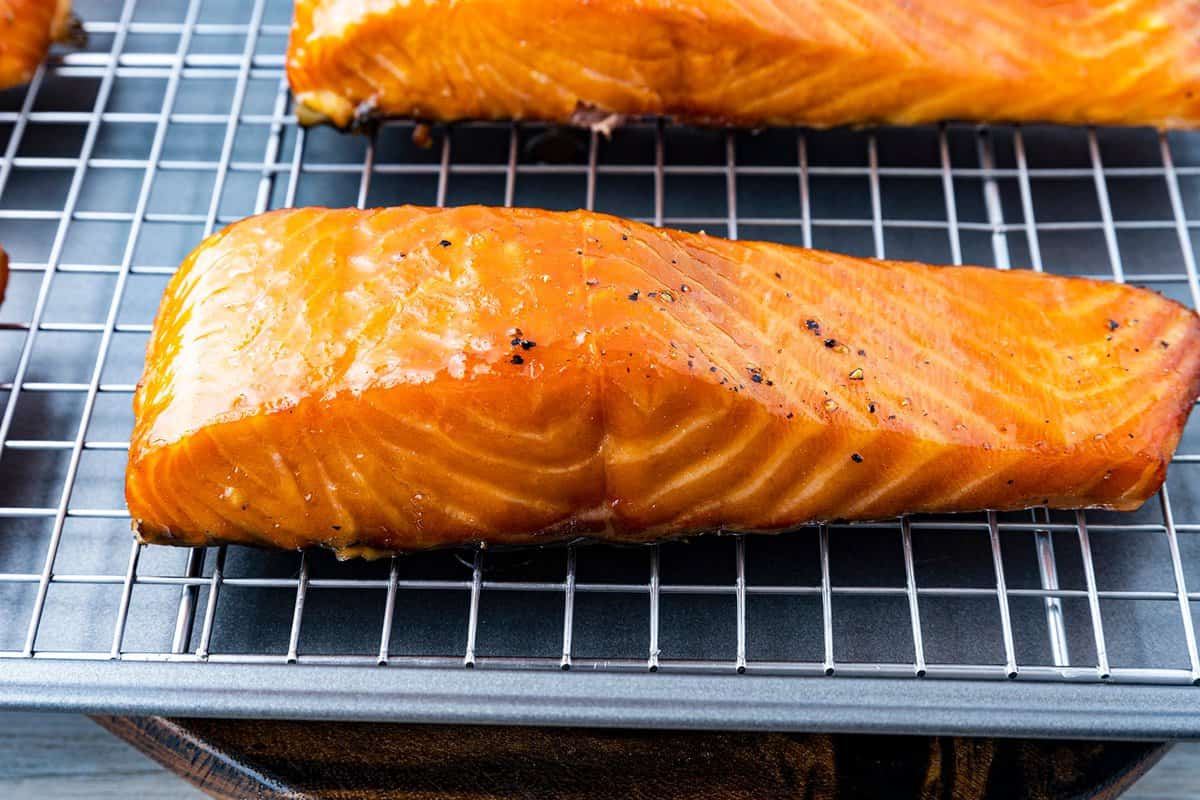
If you want “salmon bacon” you can smoke the salmon much longer: up to 5 hours. For the full salmon bacon effect, cook until the salmon is quite firm to the touch and looks like it’s been shellac-ed with the maple syrup.
Crumble smoked “salmon bacon” over salads or in rice bowls. A little of it goes a long way but it is extra special!
How to Smoke Salmon
In a long, rectangular gladware, tupperware, or other storage container with a tight fitting lid, whisk together the water, brown sugar or maple syrup, and kosher salt until the salt and sugar (if using) are fully dissolved.
Stir in the onion slabs, peppercorns, and bay leaves, then slide the salmon skin side up into the brine. Put the lid on tight and refrigerate it for at least 4 hours but up to 8 hours.
Rinse your salmon and place it on a cooling rack set on a sheet pan. Pat the surface of the fish dry with paper towels.
Place the pan in front of an electric fan in a relatively cool room for at least an hour or until the surface is shiny and somewhat tacky. Now you can either refrigerate it until the following day or go directly to the smoker with it.
Oil the skin side of the salmon fillet and place it directly on the smoker grates. Set the smoker to 165ºF. After 1 hour brush the salmon with maple syrup or honey and raise the temperature to 180ºF.
Smoke for 2 to 3 hours, or until the internal temperature of the salmon reaches 130ºF to 140ºF, brushing with maple syrup or honey every 60 minutes.
Move the smoked salmon to a cooling rack, brush once more with maple syrup or honey, and let it cool completely before wrapping tightly and refrigerating for up to a week or freezing for up to a year.
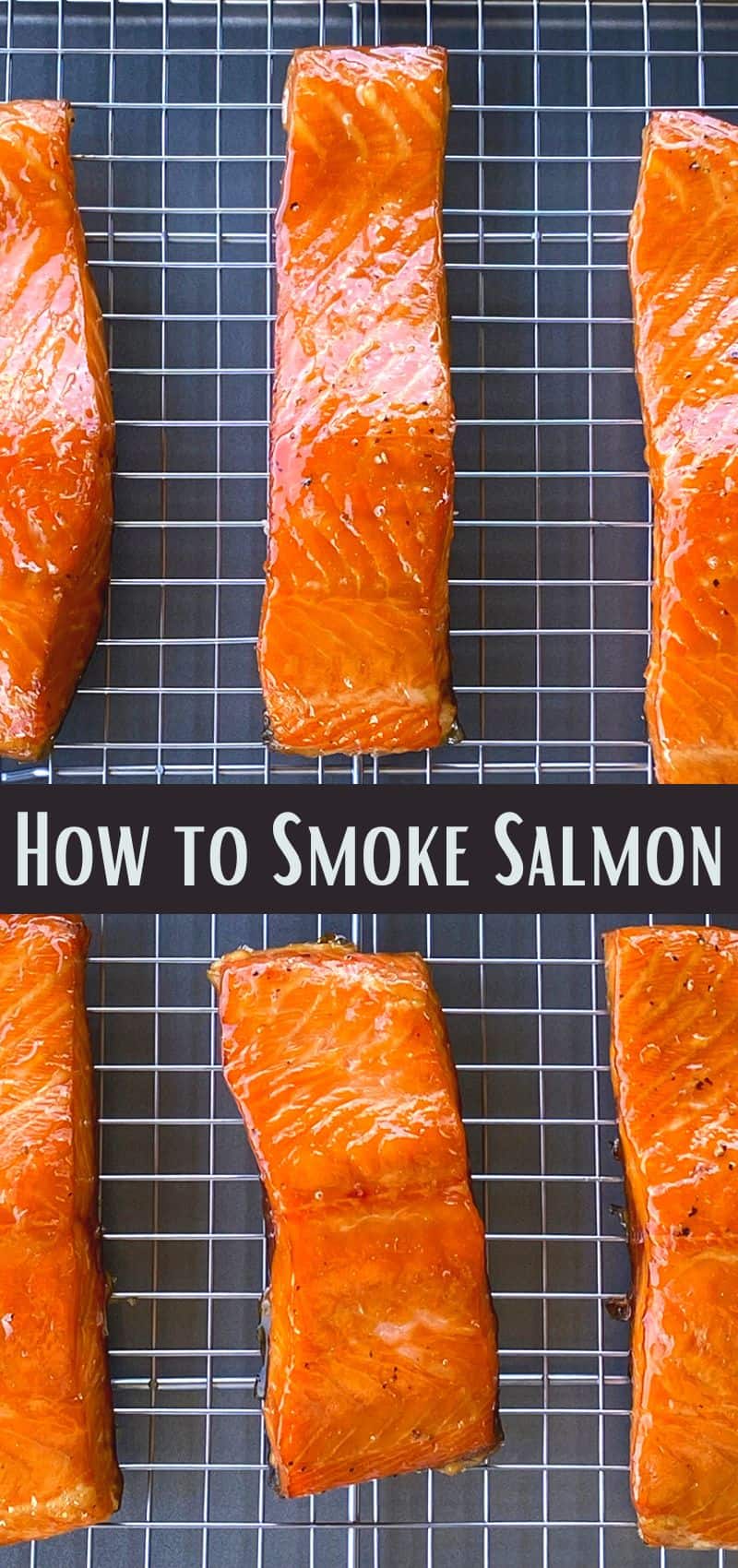
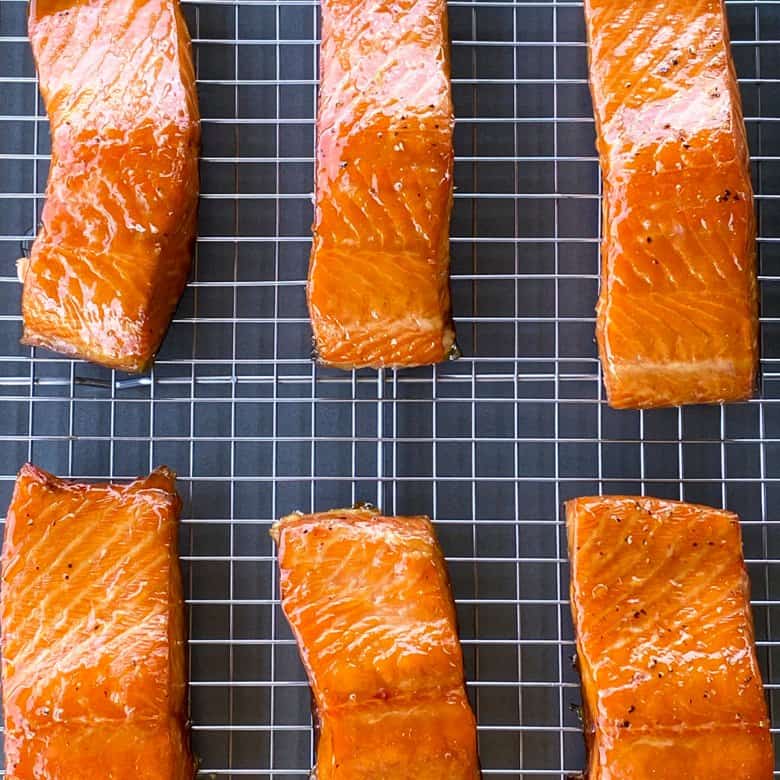
How to Smoke Salmon
Equipment
- Smoker or grill with a smoke box
- 1 cooling rack
- 1 baking sheet
- 1 rectangular container with tight fitting lid
Ingredients
- Up to 5 lbs of fresh or thawed salmon cut crosswise into 3-inch wide pieces if starting with large fillets
- ½ cup Maple syrup or honey for brushing the fish as it smokes
For the Brine:
- 4 cups cool water
- 1 cup packed, dark brown sugar, maple syrup, or honey
- 2 ounces kosher salt
- 1 red onion peeled and cut into slabs
- 1 tablespoon black peppercorns lightly smashed
- 2 bay leaves
Optional:
- 2 slices fresh lemon about ¼” thick
Instructions
- In a long, rectangular gladware, tupperware, or other storage container with a tight fitting lid, whisk together the water, brown sugar or maple syrup, and kosher salt until the salt and sugar (if using) are fully dissolved.
- Stir in the onion slabs, peppercorns, and bay leaves, then slide the salmon skin side up into the brine. Put the lid on tight and refrigerate it for at least 4 hours but up to 8 hours.
- Rinse your salmon and place it on a cooling rack set on a sheet pan. Pat the surface of the fish dry with paper towels.
- Place the pan in front of an electric fan in a relatively cool room for at least an hour or until the surface is shiny and somewhat tacky. Now you can either refrigerate it until the following day or go directly to the smoker with it.
- Oil the skin side of the salmon fillet and place it directly on the smoker grates. Set the smoker to 165ºF. After 1 hour brush the salmon with maple syrup or honey and raise the temperature to 180ºF.
- Smoke for 2 to 3 hours, or until the internal temperature of the salmon reaches 130ºF to 140ºF, brushing with maple syrup or honey every 60 minutes.
- Move the smoked salmon to a cooling rack, brush once more with maple syrup or honey, and let it cool completely before wrapping tightly and refrigerating for up to a week or freezing for up to a year.
Notes
Continue smoking the salmon for up to 5 hours or until the salmon is quite firm to the touch and looks shellac-ed; shiny and deep coral orange/brown. Transfer to a cooling rack, brush once more with maple syrup or honey, and let it cool completely before wrapping tightly and refrigerating for up to a week or freezing for up to a year.

